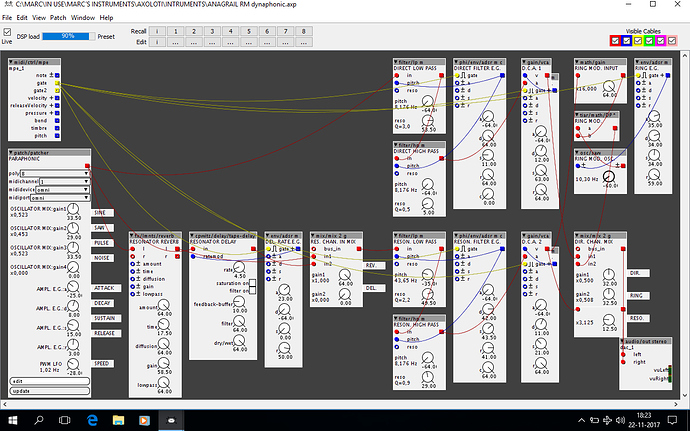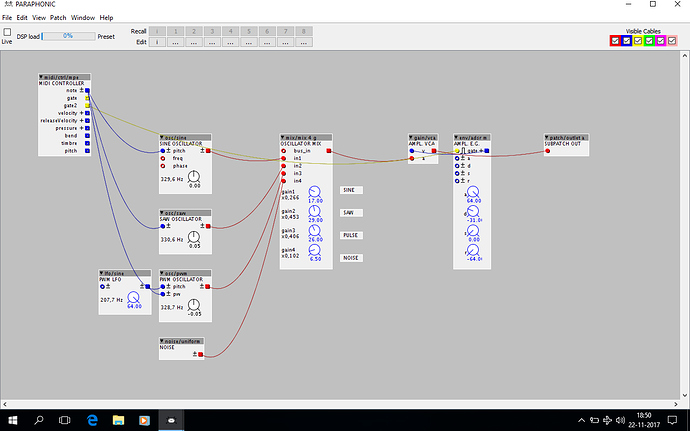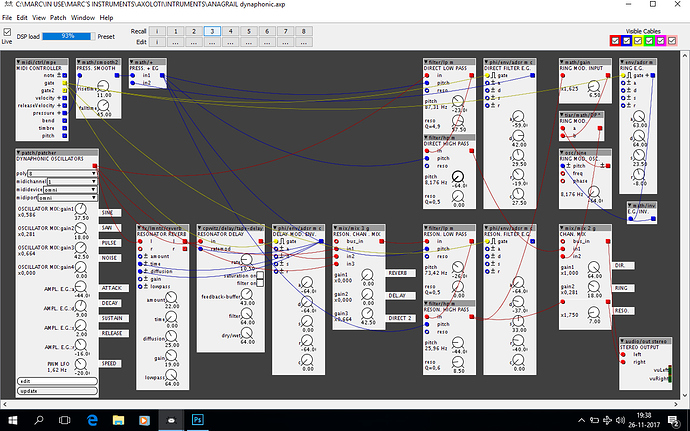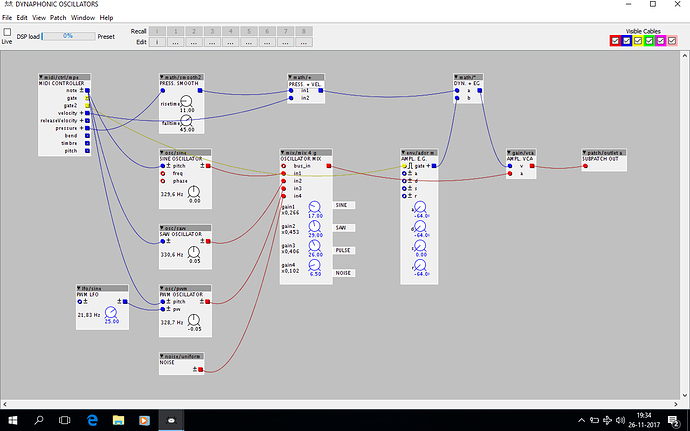As some of you might have noticed one can get in a mighty row discussing Axoloti's polyphony issues but even when a novice cracks that nut and accepts it's inherent limitations it stays a fact that one single Axoloti is quickly stretched to it's polyphonic limits.
If we compare processing power limitations to yesteryears hardware limitations a possible compromise suggests itself. It is called PARAPHONY. Beside a whole generation of string and brass instruments synthesizers like the PolyMoog, the Korg Mono/Poly and Poly 800 used it to keep complexity and thus cost down.
Simply put one creates a polyphonic section (then mostly based on organ type top down division oscillators) and grafts a monophonic filter/ VCA/ effects, etc. line on it's output. Not very efficient for playing piano concerto's but for simple chordal stuff it can be quite effective.
The screen shot shows a synthesizer that is a sort of a mix between the Yamaha CS80 and the Polymoog with an extra basic “resonator modeling” section (WHOT?) replacing the CS80's second channel.
Such esoteric choices aside (see my Holy Grail ranting elsewhere) this layout provides 2 clear advantages:
1. It's a “full” 8-voice poly. During normal polyphonic use 3 to 4 voices would be the maximum.
2. It keeps virtually all controls live in the main instrument page.
In other words this synth is reasonably high in voice count AND can be fully tweaked life.
Is there no price to pay? Yes there is. That is why I mentioned the Polymoog in the comparison.
Just like the Polymoog this synth is actually not full polyphonic. It exists somewhere between polyphonic and paraphonic (I just came up with the term dynaphonic but that will probably not stick after all these years). The difference with a normal paraphonic is that its amplitude “VCA's” still work per voice and are fully programmable. The downside is that there are only 4 filters in all, namely a low and a high pass in series per channel (Very CS indeed).
In other words: While the individual notes are fully articulated volume-wise (VCA ADSR'd so to speak) the filter setup acts more as an overall performance layer. The filters will still trigger every time a new note is played but single notes do not receive an individual filter treatment. You can even setup your MIDI-keyboard in such a way that the legato notes do not trigger the filter while non-connected notes always trigger the filter. (In my development setup I am a the moment using the Korg Prophecy, which is so friendly to provide this function automatically, at the same time proving that it actually has a polyphonic keyboard).
The actual trick I am using here is to reverse the pathway and place the amplifiers (calling them VCA's in a digitally coded instrument is actually wrong!) in front of the filters. That is not as crazy as it sounds. It used to be necessary to place the amplifiers last to avoid circuit noise bleeding through. Every voice that faded out by closing a VCA would thus also loose its full residual noise tail. In our ”noisefree” digital world this is however not of much consequence anymore. So one can just as swell put all the amplifiers before the filters and compensate eventual differences with setting up the EG's slightly differently.
In Axoloti speak these tips basically boils down to the following:
Create a keyboard object and program a subpatch into it that only contains the oscillators, a PWM control for the pulse oscillator, an oscillator submixer and a “VCA” with an envelope generator attached to it. Thus all voices in the subpatch will have a full oscillator mix and a full volume envelope. One could compare the setup with a basic electronic organ/piano but one with full waveform and ADSR control. This relatively small set of features can then be reflected on the subpatch object (right-click the mouse on the function in the subpatch and choose “parameter on parent”) without the need for an endless row of additional controls. (see overall screenshot).
Some additional remarks:
- Attention: You'll have to create a keyboard object in both the main screen and in the subpatch since you need keyboard trigger inputs in both.
- Only oscillator detuning must in this example still be performed DEAF in the subpatch screen. The tuning controls could also have been included on the subpatch module surface but I wanted to keep that as uncluttered as possible.
- When you have made everything work in mono you can try out how many voices the Axoloti's subpatch can produce. My example instrument produces 8 voices at a DSP load of just over 90 % in spite of it's rather elaborate layout (There are even 2 extra processor hungry delay type effects in it, for God's sake!).
- if you play it mono you will actually not hear any difference with a normal monophonic. If you do however insist on single note triggering you can of course still bring the voice count in the subpatch back to 1.
Yes, it's still not a true polyphonic but to trick this thing out you will still have to play some serious stuff. And if you believe an instrument like this does not amount to much you should have a listen to all the Polymoog stuff on Return To Forever / Chick Corea's Romantic Warrior album.
As far as I am concerned the biggest bummer is the lack of polyphonic aftertouch per note. I am a real sucker for that. But hey, until a more powerful version of the Axoloti comes along (please!) this is surely a reasonable alternative.
Or is it?







